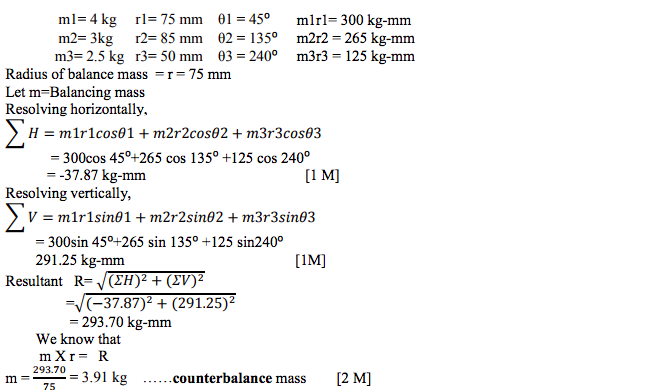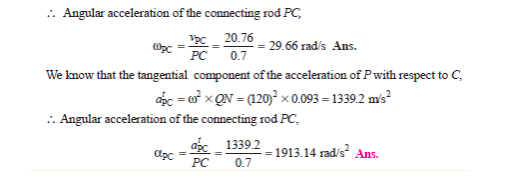CPS Question and answers
| Que.No | Question/Problem | marks | Link |
|---|---|---|---|
| Q 2 f ) |
Question:
A multiplate clutch has three pairs of contact surfaces. The outer and inner radii of the contact surfaces are 100 mm and 50 mm respectively. The maximum axial spring force is limited to 1.25 kN. If the co-efficient of friction is 0.35 and assuming uniform wear, find the power transmitted by the clutch at 1600 rpm. Answer: |
4 |
view |
| Q 3 d ) |
Question:
Find the width of the belt, necessary to transmit 7.5 kW to a pulley 300 mm diameter, if the pulley makes 1600 rpm and the co-efficient of friction between the belt and pulley is 0.3. Assume the angle of contact as 180o and the maximum tension in the belt is not to exceed 8 N/mm width. Answer:
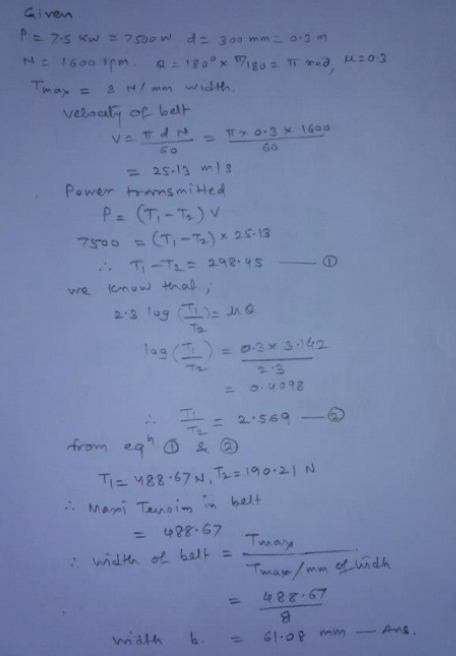 |
4 |
view |
| Q 4 f ) |
Question:
A shaft has number of collars integral with it. The external diameter of the collars is 400 mm and the shaft diameter is 250 mm. If the uniform intensity of pressure is 0.35 N/mm2 and its co-efficient of friction is 0.05; find (i) power absorbed in overcoming friction when shaft rotates at 105 rpm and carries a load of 150 kN, and (ii) number of collars required. Answer:
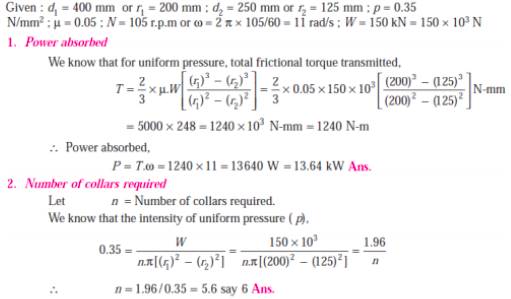 |
4 |
view |
| Que.No | Question/Problem | marks | Link |
|---|---|---|---|
| Q 2 f ) |
Question:
A shaft runs at 80 rpm & drives another shaft at 150 rpm through belt drive. The diameter of the driving pulley is 600 mm. Determine the diameter of the driven pulley in the following cases: (i) Taking belt thickness as 5 mm. (ii) Assuming for belt thickness 5 mm and total slip of 4%. Answer:
|
4 |
view |
| Q 3 b ) |
Question:
In a slider crank mechanism, crank AB = 20 mm & connecting rod BC = 80 mm. Crank AB rotates with uniform speed of 1000 rpm in anticlockwise direction. Find (i) Angular velocity of connecting rod BC (ii) Velocity of slider C. When crank AB makes an angle of 60 degrees with the horizontal. Draw the configuration diagram also. Use analytical method. Answer:
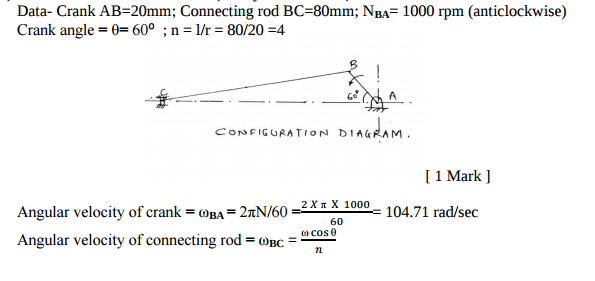  |
4 |
view |
| Q 4 e ) |
Question:
A multiplate disc clutch transmits 55 kW of power at 1800 rpm. Coefficient of friction for the friction surfaces is 0.1. Axial intensity of pressure is not to exceed 160 kN/m2 . The internal radius is 80 mm and is 0.7 times the external radius. Find the number of plates needed to transmit the required torque. Answer:
  |
4 |
view |
| Q 4 f ) |
Question:
A rotor having the following properties : m1 = 4 kg r1 = 75 mm θ1 = 45o m2 = 3 kg r2 = 85 mm θ2 = 135o m3 = 2.5 kg r3 = 50 mm θ3 = 240o Determine the amount of the countermass at a radial distance of 75 mm required for the static balance. Answer:
|
4 |
view |
| Que.No | Question/Problem | marks | Link |
|---|---|---|---|
| Q 1b)(iii) |
Question:
The central distance two shaft is 4m having two pulleys with diameter having 500mm and 700mm respectively find the length of belt required - (1) for open belt drive (2) for cross belt drive Answer:
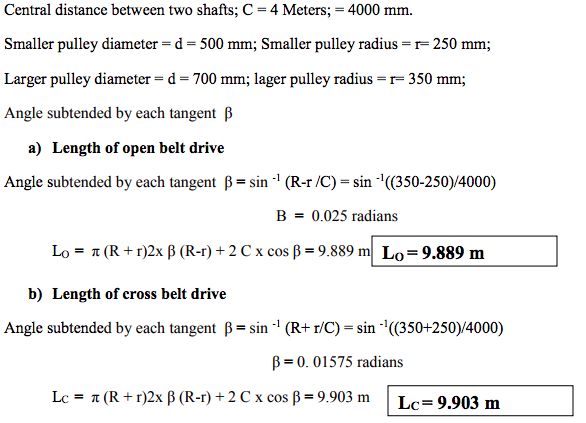 |
4 |
view |
| Q 2 f ) |
Question:
A pulley is driven by the flat belt running at speed of 600m/min. and transmit 4 kW. The coefficient of friction between belt and pulley is 0.3 and angle of lap is 160°. Find maximum tension in the belt. Answer:
|
4 |
view |
| Q 3 d ) |
Question:
Three masses 10 kg, 20 kg and 15kg are attached at a point at radii of 20 cm, 25cm and 15 cm respectively. If the angle between successive masses is 60° and 90°. Determine analytically the balancing mass to be attached at radius of 30cm. Answer: |
4 |
view |
| Que.No | Question/Problem | marks | Link |
|---|---|---|---|
| Q 2 f ) |
Question:
The central distance between two shaft is 4 m having two pulleys with diameter having 500 mm and 700 mm respectively. Find length of belt required (i) for open belt drive (ii) for cross belt drive Answer:
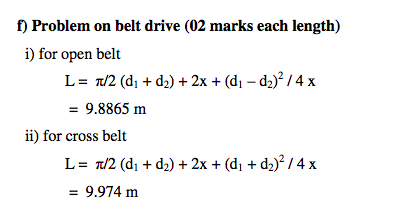 |
4 |
view |
| Q 3 f ) |
Question:
Crank OA of a mechanism is hinged at ‘O’ and rotates at an angular velocity of 20 rad/sec. and angular acceleration of 25 rad/sec2 . If crank OA is 50 mm long determine linear velocity, centripetal acceleration and tangential acceleration of a point A. Answer:
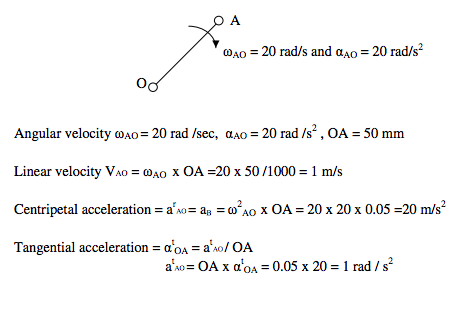 |
4 |
view |
| Q 4 e ) |
Question:
Three masses 10 kg, 20 kg and 15 kg are attached at a point at radii of 20 cm, 25 cm and 15 cm respectively. If the angle between successive masses is 60° and 90°. Determine analytically the balancing mass to be attached at radius of 30 cm. Answer:
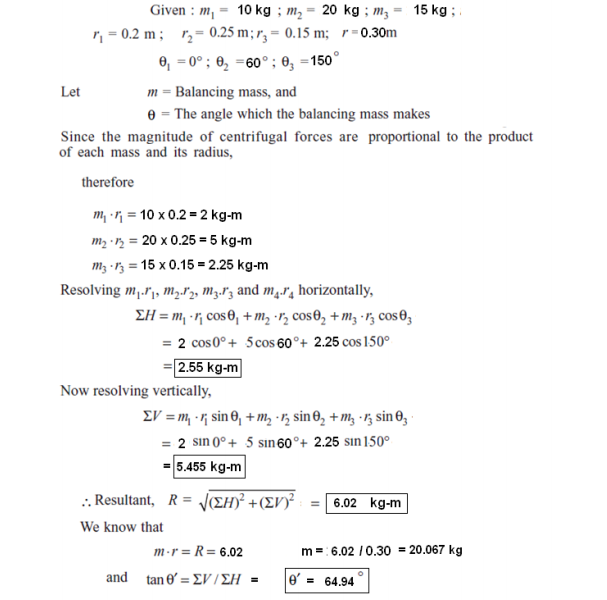 |
4 |
view |
| Q 4 f ) |
Question:
A thrust shaft of a ship has 6 collar of 600 mm external diameter and 300 mm internal diameter. The total thrust from the propeller shaft is 100 kN. If the coefficient of friction is 0.12 and speed of engine 90 rpm. Find power absorbed in friction at the thrust block using uniform pressure intensity condition. Answer:
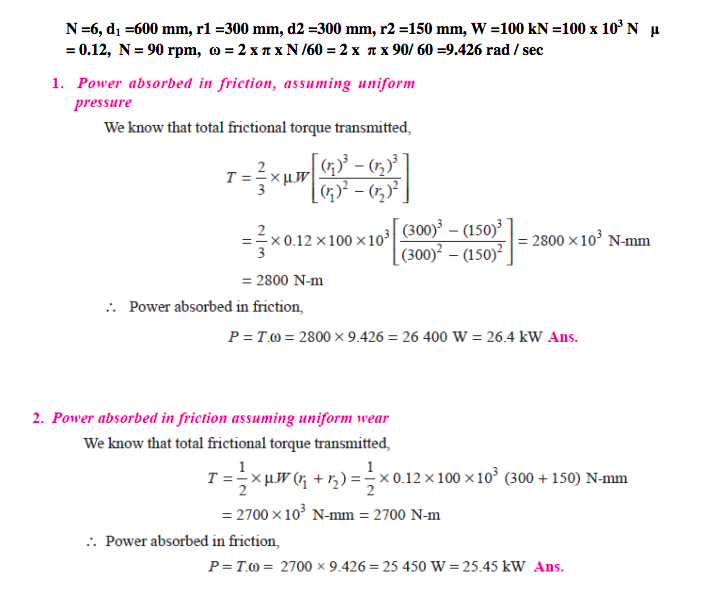 |
4 |
view |
| Q 6a)(i) |
Question:
(i) Define ‘Gear Train’. State its purpose and types of gear train.
Answer:
|
4 |
view |
| Que.No | Question/Problem | marks | Link |
|---|---|---|---|
| Q 5 a ) |
Question:
The crank and connecting rod of a reciprocating engine are 200 mm and 700 mm respectively. The crank is rotating in clockwise direction at 120 rad/s. Draw Klein’s construction and find (i) Velocity and acceleration of the piston (ii) Angular velocity and angular acceleration of the connecting rod at the instant when the crank is at 30° to IDC (inner dead centre). Answer:
|
4 |
view |

